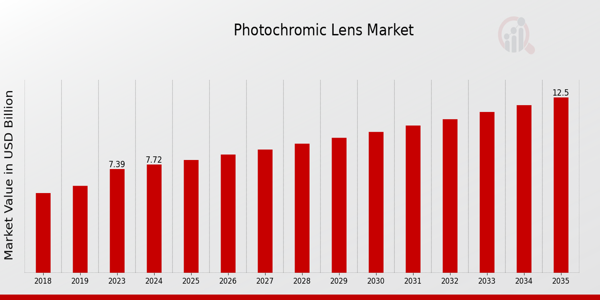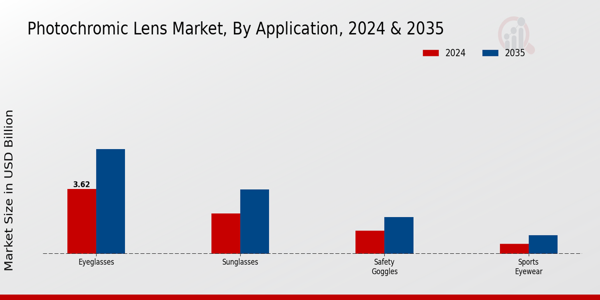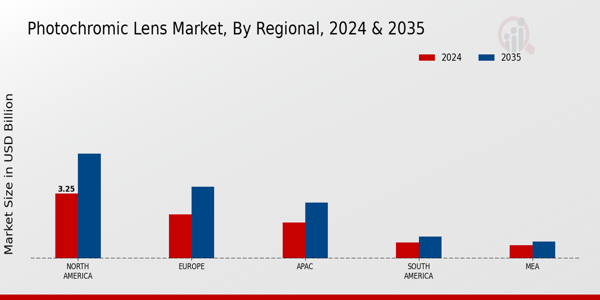Photochromic Lens Market Overview
Photochromic Lens Market Size was estimated at 7.39 (USD Billion) in 2023. The Photochromic Lens Market Industry is expected to grow from 7.72(USD Billion) in 2024 to 12.5 (USD Billion) by 2035. The Photochromic Lens Market CAGR (growth rate) is expected to be around 4.48% during the forecast period (2025 - 2035).
Key Photochromic Lens Market Trends Highlighted
The Global Photochromic Lens Market is experiencing notable growth driven by increasing awareness of eye health and enhanced demand for protective eyewear. The rise in outdoor activities has led consumers to seek solutions that offer convenience and adaptability in various lighting conditions. Additionally, the growing aging population is another key market driver, as older individuals often require corrective lenses and can greatly benefit from photochromic technology that reduces glare and improves visual comfort. As lifestyles evolve, consumers are more inclined to invest in eyewear that not only corrects vision but also provides protection from harmful UV rays.O pportunities to be explored in the market include the rise of smart and connected eyewear. Innovation in lens technology is paving the way for hybrid solutions that merge traditional photochromic features with augmented reality functionalities. This trend indicates a shift towards more technologically advanced eyewear that meets the varied needs of consumers. Moreover, increasing disposable incomes in emerging markets create a fertile ground for manufacturers to introduce photochromic lenses tailored to different socio-economic segments, enhancing accessibility. Recent trends in the industry reveal a growing emphasis on sustainable and eco-friendly materials in lens production.As consumers become more environmentally conscious, brands that adopt sustainable practices stand to gain a competitive advantage. Collaborations between eyewear manufacturers and technology firms are also becoming common, leading to the development of innovative products that appeal to a tech-savvy audience. Overall, the market is evolving rapidly, driven by consumer demand for versatility, functionality, and sustainability in eyewear products.

Source: Primary Research, Secondary Research, MRFR Database and Analyst Review
Photochromic Lens Market Drivers
Increasing Awareness of Eye Health
The rising awareness regarding eye health and the importance of protective eyewear has significantly contributed to the growth of the Global Photochromic Lens Market Industry. As more people become informed about the detrimental effects of ultraviolet (UV) rays and blue light exposure, there has been a noticeable shift in consumer behavior toward purchasing eyewear that offers enhanced protection. This trend is particularly prevalent among individuals who spend extended periods outdoors or in front of digital screens, as they seek solutions that not only improve their vision but also shield their eyes from harmful radiation.Another key consideration is that many older adults have some eye issues, which makes them more inclined to use special lenses. Most manufacturers are proactively adjusting their offerings to capitalize on this prospect and boost the Global Photochromic Lenses Market. As resources indicate, it is predicted that the market value will grow substantially.
Technological Advancements in Lens Manufacturing
Technological innovations within the lens manufacturing sector have played a crucial role in the expansion of the Global Photochromic Lens Market Industry. Advancements in materials and production techniques, such as the introduction of high-performance photochromic chemicals, have enabled the creation of lenses that respond more effectively to changes in light conditions. This improvement enhances customer experience, as lenses are now more responsive, offer superior clarity, and have a faster transition time from dark to light and vice versa.As these technologies continue to evolve, they are expected to provide new opportunities for market players, further driving the demand for photochromic lenses globally.
Growing Fashion Trends in Eyewear
The increasing trend of eyewear as a fashion statement has fueled the growth of the Global Photochromic Lens Market Industry. Consumers are now looking for eyeglasses that not only serve functional purposes but also align with their personal style and self-expression. As fashion-conscious individuals seek both aesthetic appeal and advanced lens technology, photochromic lenses offer a unique blend of functionality and style, making them an attractive choice.Brands are capitalizing on this trend by launching new product lines that incorporate various frame styles and colors, which supports greater visibility in the market and drives sales.
Photochromic Lens Market Segment Insights
Photochromic Lens Market Application Insights
The Global Photochromic Lens Market revenue reflects a growing trend toward adaptive eyewear solutions, driven by the increasing demand for personalized vision protection across various applications. In 2024, the valuation of the market is 7.72 USD Billion, showcasing considerable consumer interest. The segment of Eyeglasses holds a substantial market position, valued at 3.62 USD Billion in 2024 and projected to reach 5.83 USD Billion by 2035. This growth is attributed to the rising emphasis on eye health and the versatility of photochromic lenses, which enhance comfort in varying light conditions.Sunglasses represent another significant area, valued at 2.25 USD Billion in 2024 and expected to grow to 3.59 USD Billion by 2035, underlining their popularity among consumers seeking stylish yet functional alternatives for sun protection. Safety Goggles are also a crucial segment, with their value standing at 1.29 USD Billion in 2024 and anticipated to increase to 2.04 USD Billion in 2035, driven by stringent safety regulations across industries and a heightened awareness of occupational hazards. Finally, Sports Eyewear, although smaller in valuation at 0.56 USD Billion in 2024, is projected to see growth to 1.04 USD Billion by 2035, fueled by the rising popularity of outdoor sports and recreational activities requiring specialized vision gear.The Global Photochromic Lens Market segmentation illustrates a clear inclination towards multifunctional lenses, highlighting the industry’s adaptation to consumer needs and the growing market craving for safety, style, and convenience in eyewear.

Source: Primary Research, Secondary Research, MRFR Database and Analyst Review
Photochromic Lens Market Material Type Insights
The market segmentation highlights materials such as Plastic, Polycarbonate, Trivex, and Glass, each playing a vital role in the overall landscape. Plastic lenses are typically favored for their lightweight properties and comfort, while Polycarbonate lenses are known for their superior impact resistance, making them a preferred choice for children and active individuals.Trivex, known for its optical clarity and strength, appeals to those seeking high-performance eyewear. Glass lenses, though heavier, offer excellent scratch resistance and clarity, making them popular in specific niches. The growth of the Global Photochromic Lens Market is driven by increasing consumer awareness regarding eye health and the demand for high-performance eyewear, presenting significant opportunities. However, challenges such as competition from alternative lens materials and price sensitivity need to be addressed. Overall, the demand for diverse material types continues to shape the Global Photochromic Lens Market trends and statistics as it moves forward toward a projected value of 12.5 USD billion by 2035.
Photochromic Lens Market End Use Insights
The Global Photochromic Lens Market encompasses a variety of end-use applications, reflecting the diverse needs of consumers and professionals. Individuals represent a significant segment, utilizing these lenses for everyday convenience and eye protection, particularly in outdoor settings. Healthcare professionals also rely on photochromic technology, valuing lenses that enhance visual comfort during prolonged patient interactions.Sports enthusiasts benefit from photochromic lenses that adapt to various lighting conditions, improving performance and safety. Meanwhile, industrial workers find essential value in these lenses, as they provide protection against harmful UV rays while working outdoors. The diversity in application underscores the importance of this market segment, which continues to evolve due to market growth factors such as increased awareness about eye care and innovative product developments. With a steady CAGR projected, the Global Photochromic Lens Market presents ongoing opportunities for various end-users, each contributing significantly to the overall market dynamics.
Photochromic Lens Market Feature Insights
This growth is driven by various features offered by photochromic lenses, which enhance user experience and safety. The Transition Effect feature is increasingly preferred for its ability to adapt to changing light conditions, making it valuable for outdoor enthusiasts. UV Protection remains a critical aspect, as consumers are becoming more aware of the harmful effects of UV rays on eye health, positioning this feature as a priority for many users.Anti-reflective coatings are also gaining traction, as they improve visual comfort by reducing glare, which is especially important for those who spend long hours in front of screens. Scratch Resistance is another feature that is vital, as it prolongs the lens lifespan and maintains clarity over time. Collectively, these features represent significant contributions to the Global Photochromic Lens Market revenue and highlight a trend toward lenses that not only enhance visual comfort but also protect eye health, demonstrating the dynamic nature of the Global Photochromic Lens Market industry and its segmentation.The market growth is influenced by shifting consumer preferences towards high-quality, feature-rich eyewear that meets both functional and aesthetic needs.
Photochromic Lens Market Regional Insights
The Global Photochromic Lens Market is projected to reach a significant valuation, with North America expected to dominate, accounting for 3.25 USD Billion in 2024 and growing to 5.25 USD Billion in 2035, showcasing its majority holding in this segment. Europe follows closely behind, with a market value of 2.2 USD Billion in 2024 and rising to 3.6 USD Billion in 2035, indicating its critical role in the industry's growth. The Asia-Pacific region represents a notable portion as well, with values starting at 1.8 USD Billion in 2024 and reaching 2.8 USD Billion by 2035, driven by increasing consumer awareness and demand for advanced eyewear solutions.South America and the MEA markets are smaller, with valuations of 0.8 USD Billion and 0.67 USD Billion in 2024, respectively, but show promise as the regions develop their optical markets, with values projected to reach 1.1 USD Billion and 0.85 USD Billion by 2035. This segmentation illustrates varied growth dynamics, influenced by regional trends, demographic factors, and the rise in outdoor activities boosting demand for photochromic lenses across different territories.

Source: Primary Research, Secondary Research, MRFR Database and Analyst Review
Photochromic Lens Market Key Players and Competitive Insights
The Global Photochromic Lens Market is a dynamic and rapidly evolving sector characterized by significant competition among various manufacturers and suppliers. Driven by advancements in lens technology and growing consumer awareness regarding eye protection, the market has experienced notable growth in recent years. As more customers opt for eyewear solutions that offer convenience and protection from UV rays, businesses in this segment have had to innovate continuously to meet market demands. The competitive landscape includes key players that leverage technology to enhance the performance of photochromic lenses, contributing to a growing trend of personalization and customization in eyewear. This competitive environment fosters ongoing research and development, enabling companies to refine their products and expand their market reach. Hoya Corporation has established a prominent presence within the Global Photochromic Lens Market thanks to its strong emphasis on technological innovation and high-quality manufacturing processes. The company is well-known for its advanced lens technologies that enhance the photochromic effect, providing seamless transitions between clear and tinted states. Hoya Corporation's focus on research and development enables it to introduce cutting-edge products that cater to the evolving preferences of consumers, such as lightweight options and lenses with superior clarity. Moreover, Hoya maintains a robust distribution network that allows for effective market penetration and collaboration with eyewear retailers. The company’s unwavering commitment to customer satisfaction and product performance has solidified its reputation as a reliable provider of photochromic lenses, positioning it favorably against competitors. Kasper Optical is another noteworthy player in the Global Photochromic Lens Market, recognized for its unique approach to optical solutions and customer-centric offerings. With a reputation for quality and innovation, Kasper Optical has carved a niche for itself by producing a diverse range of photochromic lenses that address specific consumer needs. The company focuses on creating lenses that not only react effectively to light changes but also incorporate style and comfort into their design. By emphasizing the aesthetic appeal of their products alongside functionality, Kasper Optical attracts a broad customer base. Additionally, their efforts in expanding distribution channels and collaborating with optical retailers have strengthened their presence in the market. The company's dedication to enhancing user experience through systematic innovations and comprehensive product lines has positioned it strategically in the competitive landscape of photochromic lenses.
Key Companies in the Photochromic Lens Market Include
- Hoya Corporation
- Kasper Optical
- Bausch Health Companies
- Carl Zeiss AG
- Marcolin S.p.A
- Shamir Optical Industry
- Takagi
- Younger Optics
- Safilo Group
- Vision Service Plan
- Johnson and Johnson Vision
- EssilorLuxottica
- Rodenstock
- Mido Optical
Photochromic Lens Market Industry Developments
The Global Photochromic Lens Market has recently experienced notable developments, particularly due to increasing consumer demand for advanced lens technology that offers protection against harmful UV rays and enhances visual comfort. Companies like Hoya Corporation and EssilorLuxottica have been enhancing their product portfolios by integrating smart features and innovative materials, reflecting a shift towards high-performance lenses.
Additionally, collaborations and strategic partnerships are becoming common, as seen with Bausch Health Companies and Carl Zeiss AG, focusing on expanding their market presence. Recent mergers and acquisitions have sparked interest in the sector, with companies like Marcolin S.p.A and Younger Optics pursuing opportunities to diversify offerings and capture emerging market segments. The growth in market valuation, especially among firms such as Safilo Group and Rodenstock, indicates a positive trend as they adapt to evolving consumer preferences and invest in research and development. As the market evolves, the emphasis on sustainability and eco-friendly manufacturing processes is also gaining traction, signaling a broader shift within the photonic materials industry towards more responsible practices. The overall market dynamics suggest a robust future for photochromic lens innovation and consumer accessibility.
Photochromic Lens Market Segmentation Insights
Photochromic Lens Market Application Outlook
- Eyeglasses
- Sunglasses
- Safety Goggles
- Sports Eyewear
Photochromic Lens Market Material Type Outlook
- Plastic
- Polycarbonate
- Trivex
- Glass
Photochromic Lens Market End Use Outlook
- Individuals
- Healthcare Professionals
- Sports Enthusiasts
- Industrial Workers
Photochromic Lens Market Feature Outlook
- Transition Effect
- UV Protection
- Anti-Reflective
- Scratch Resistance
Photochromic Lens Market Regional Outlook
- North America
- Europe
- South America
- Asia Pacific
- Middle East and Africa
|
Report Attribute/Metric
|
Details
|
|
Market Size 2023
|
7.39(USD Billion)
|
|
Market Size 2024
|
7.72(USD Billion)
|
|
Market Size 2035
|
12.5(USD Billion)
|
|
Compound Annual Growth Rate (CAGR)
|
4.48% (2025 - 2035)
|
|
Report Coverage
|
Revenue Forecast, Competitive Landscape, Growth Factors, and Trends
|
|
Base Year
|
2024
|
|
Market Forecast Period
|
2025 - 2035
|
|
Historical Data
|
2019 - 2024
|
|
Market Forecast Units
|
USD Billion
|
|
Key Companies Profiled
|
Hoya Corporation, Kasper Optical, Bausch Health Companies, Carl Zeiss AG, Marcolin S.p.A, Shamir Optical Industry, Takagi, Younger Optics, Safilo Group, Vision Service Plan, Johnson and Johnson Vision, EssilorLuxottica, Rodenstock, Mido Optical
|
|
Segments Covered
|
Application, Material Type, End Use, Feature, Regional
|
|
Key Market Opportunities
|
Rising demand for prescription eyewear,
Growing popularity of outdoor activities,
Increasing awareness of UV protection,
Innovations in lens technology,
Expansion in developing markets
|
|
Key Market Dynamics
|
Growing awareness of UV protection,
Increasing demand for outdoor activities,
Advancements in lens technology,
Rising prevalence of vision disorders,
Customization and fashion trends in eyewear
|
|
Countries Covered
|
North America, Europe, APAC, South America, MEA
|
Frequently Asked Questions (FAQ) :
The Global Photochromic Lens Market is expected to be valued at 7.72 billion USD in 2024.
By 2035, the Global Photochromic Lens Market is projected to reach a value of 12.5 billion USD.
The Global Photochromic Lens Market is expected to grow at a CAGR of 4.48% from 2025 to 2035.
The eyeglasses segment dominates the market with a value of 3.62 billion USD in 2024.
The sunglasses segment is anticipated to grow from 2.25 billion USD in 2024 to 3.59 billion USD in 2035.
The safety goggles segment is valued at 1.29 billion USD in 2024.
Major players include Hoya Corporation, Bausch Health, and EssilorLuxottica among others.
In 2024, the North America region accounts for a market value of 3.25 billion USD.
The Asia-Pacific region is projected to have a market value of 2.8 billion USD by 2035.
The sports eyewear segment is expected to reach a value of 1.04 billion USD by 2035.
















